Growing mushrooms in a greenhouse
One of the most popular and demanded areas in modern agriculture is growing mushrooms in greenhouses. Mushrooms are one of the largest sources of plant protein, fiber, carbohydrates, vitamin D and magnesium. In addition, mushrooms are very tasty and can be used to prepare a wide variety of dishes. The huge abundance of varieties and types of this wonderful product will not leave you indifferent. The only drawback of mushrooms is their seasonality, but greenhouse cultivation makes it possible to collect fresh and fragrant mushrooms all year round.
Learn how to grow champignons and oyster mushrooms in a greenhouse!
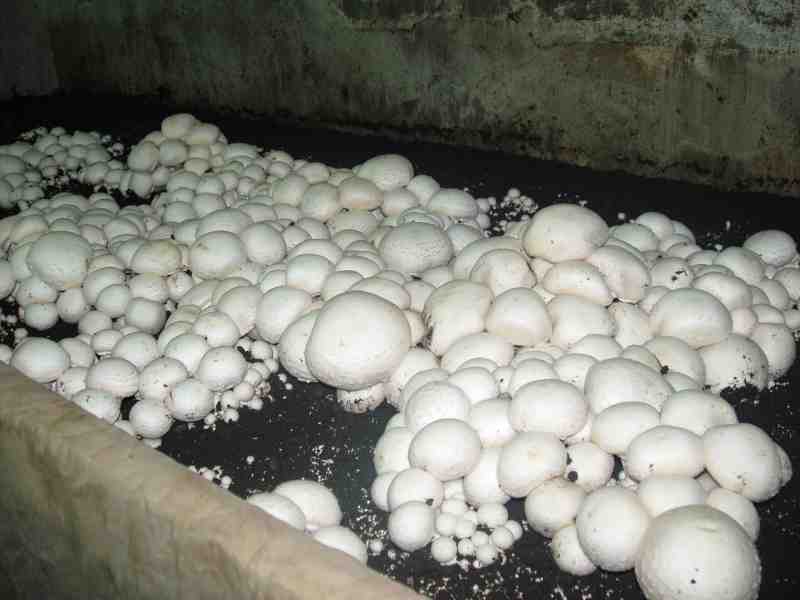
Content
Features of growing mushrooms in a greenhouse, advantages
Mushrooms are absolutely unpretentious plants, so there are practically no problems with planting and growing them. It is important to competently:
- equip a greenhouse,
- determine the varieties of mushrooms that will grow in it,
- prepare the ground,
- adjust the temperature mode,
- and continue to provide proper care.
A mushroom greenhouse does not differ at all from a vegetable one. If a vegetable greenhouse already exists on the site so that it is not empty in winter, it can be used as a mushroom greenhouse.
Remember! The main advantage of growing mushrooms in a greenhouse is their year-round availability, unpretentious maintenance, and frequent harvesting.
The process of growing mushrooms can be noted as being particularly economical, since it does not require any additional costs in the form of fertilizers, agrochemistry and other additives, such as vegetables or fruits. Labor costs are minimal, and special knowledge and skills in mushroom growing are not required.
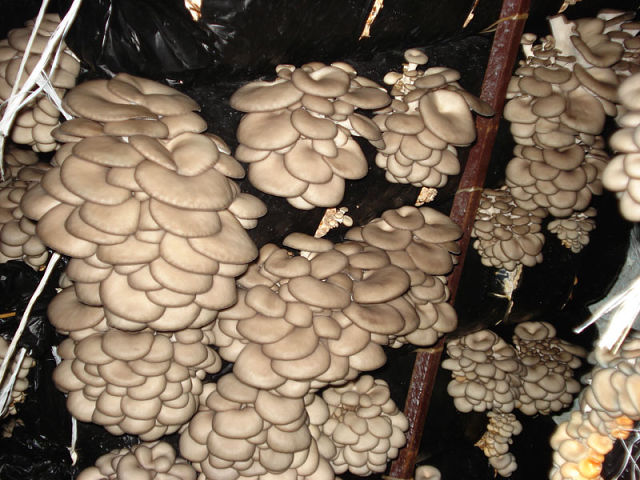
Note! Depleted myceliums, which no longer bear fruit, are recommended to be used as an active fertilizer for both fruit and ornamental garden and indoor plants.
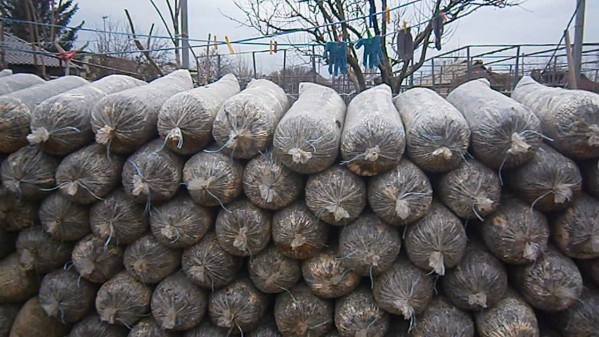
Greenhouse varieties
In a well-equipped greenhouse, you can grow almost any type of mushroom designed for this. The following mushrooms can be grown in a greenhouse:
- shiitake;
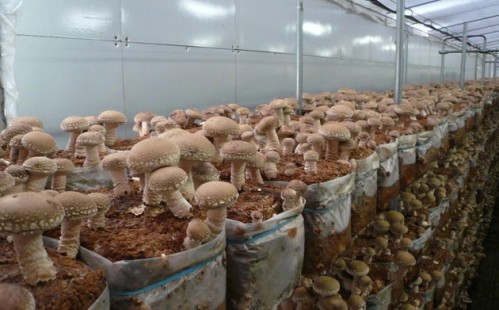
- Champignon;
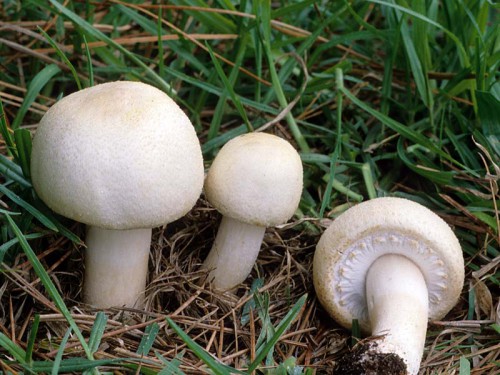
- oyster mushrooms;
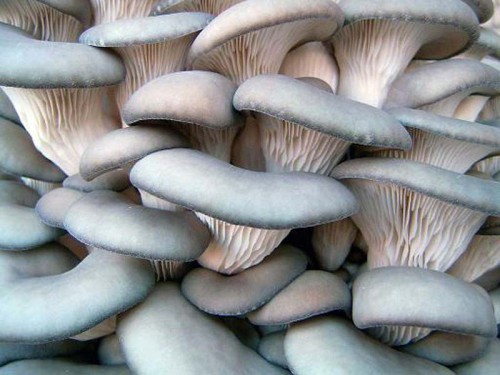
- White mushrooms.
The most popular among greenhouse breeding are champignons, oyster mushrooms andporcini mushrooms (which cannot be grown at home, although people try and get disappointed). These varieties are most in demand in the culinary and food market, so growing them can be turned into good business.
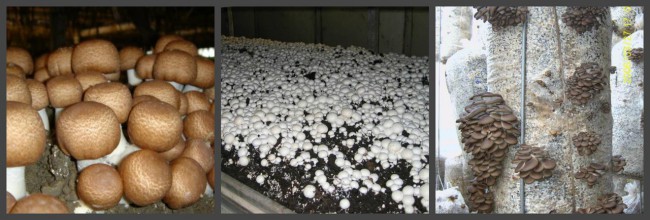
What should be a greenhouse for growing mushrooms
It is generally accepted that a separate greenhouse is needed for each type of mushroom. In principle, this is the case when it comes to large companies involved in growing this product for a wide market. But, if we are talking about small quantities, then the greenhouse can be universal for several types of mushrooms at once.
It is customary to grow mushrooms in the cold season from October to April, therefore, an ordinary greenhouse from a film that has already been freed from vegetables is suitable for growing. It will also be an ideal option for breeding the most popular and delicious mushrooms - champignons. These mushrooms love light and warmth.
For oyster mushrooms, basements and cellars are suitable, of course, if they have a minimum level of lighting, sufficient temperature and humidity.
Now regarding the greenhouse itself for growing mushrooms. It is possible to grow cultivated species of mushrooms in a building from any materials (be it wood, plastic, film, block or others), if the following elements are present:
- Heating system, the preferred water type. Thanks to this setting, the air in the greenhouse remains moist, which is important for plants.
- Tightness of the structure and good insulation... This is very important for maintaining a constant microclimate in the greenhouse.
- Availability of air conditioning or exhaust ventilation systems... Mushrooms are very fond of fresh air.
- Unimpeded access to water... Myceliums must be frequently moistened and done by spraying water. If the greenhouse is huge, then it is worth equipping it with special spray systems. If it is small, then you can do it manually.
- Protected from direct sunlight. To do this, it is enough to whitewash the roof of the greenhouse with lime or additionally stretch another layer of less transparent (matte) film.
- Depending on the type of mushroom, equip racks for hanging nets with myceliums or racks for container installation.
In fact, these are all the key elements of the mushroom greenhouse equipment.
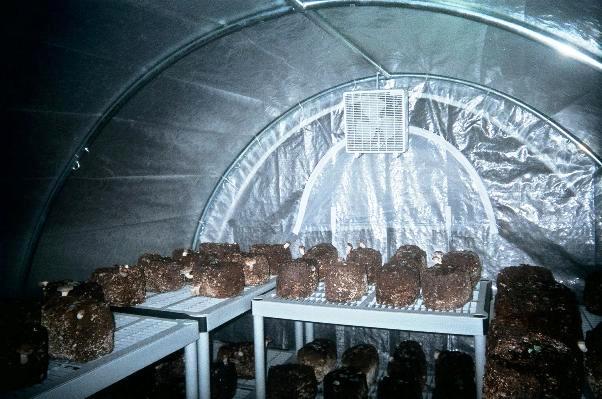
The heating system can be isolated as a separate item. As already mentioned above, the heating system must be water-based, which is very easy to connect from the main heating of the house using a balancing valve. This equipment makes it possible to regulate the temperature within the required limits. The power of the heating equipment directly depends on the size (quadrature) of the greenhouse.
Lighting is another important aspect of greenhouse equipment. During the period when the sunny day is quite long, there are no problems with this, but in the cold season, the plants sorely lack daylight, so there is a need for backlighting.
Daylight will be enough for growing oyster mushrooms even in winter. These mushrooms do not require light. A completely different situation with cultivation in a greenhouse champignons that need a lot of light... In large garden centers and specialized gardening stores, you can find the equipment you need for greenhouses, in particular lighting. As a rule, in mushroom greenhouses, fluorescent lamps with diffused lighting are used, since myceliums cannot tolerate direct exposure to light rays. Each lamp has its own trajectory, so their number is determined by the area of the greenhouse.
Video: what should be a room for growing mushrooms
How to grow mushrooms in a greenhouse
Many people say that mushrooms are a very capricious material to grow, but this is completely wrong. The whole difficulty of growing mushrooms in a greenhouse lies in preparing the soil for growing, because it will be individual for each variety. And, of course, the variety itself plays an important role, which will be discussed below.
Features of growing mushrooms
A bountiful harvest champignons in a greenhouse, 70% depends on a properly prepared compost base and the quality of the planting material.
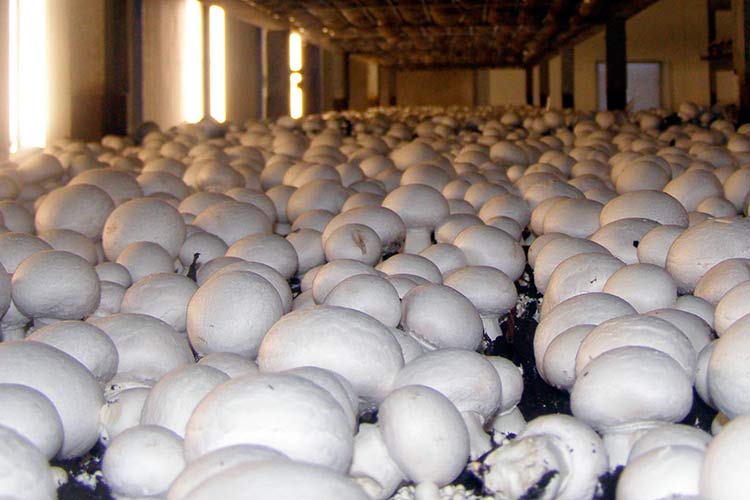
Substrate preparation
Compost material for growing mushrooms in a greenhouse is prepared on the basis of straw and horse straw manure. Straw can be replaced with dry garden grass or tops of cultivated plants (corn, beets, squash). Grass or straw should not be rotten, only well dried!
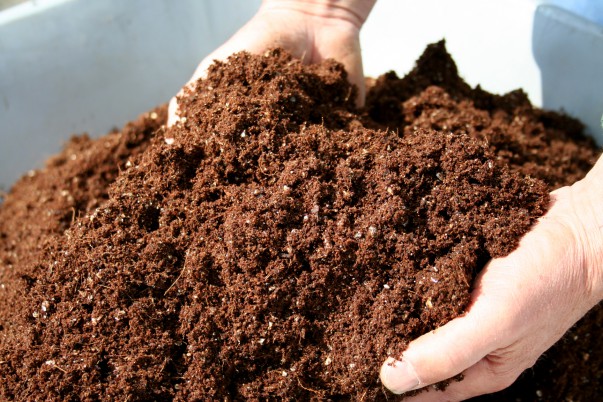
To create compost for growing mushrooms you will need:
- straw / grass (10 kg);
- horse manure (5 kg). Pig, cow, or rabbit manure can also be used, but these are less fertile;
- urea (30 g);
- superphosphate (30 g);
- gypsum (300 g);
- water (30 l).
All these ingredients must be mixed and left in the open air. The compost will form within 10 days, after which it can be used for planting myceliums.
Video: preparing a substrate for growing mushrooms in a greenhouse
Landing
There are many ways to arrange champignons, depending on the design of the greenhouse and the placement of the shelves. The easiest way is to construct several long shelves, cover them with oilcloth and distribute the compost evenly. The temperature in the greenhouse should not be lower than 30 ° C, since the temperature of the compost during planting should not be lower than 25 ° C. Once optimal conditions are reached, disembarkation can be carried out.
The mycelium (fungal spores) is spread evenly throughout the compost at a depth of 6 cm by stirring. After sowing, the surface is slightly compacted and covered with special paper.
Video: planting champignons
Care
The compost material is moistened, since a large amount of water is used during cooking, besides, straw makes it possible to retain moisture for as long as possible, and paper creates a greenhouse effect. The optimum temperature inside the greenhouse is 25 ° C.
The first shoots in the form of a spider web, on which silver balls will be visible, will appear within 3 weeks after planting. Irrigation is carried out every 3 days. After germination, the temperature can be reduced by 8-10 degrees.
Harvesting
Already 16-20 days from the moment of planting, the first greenhouse harvest can be harvested. Champignons will give birth in influx, after the first harvest, it will take 5-10 days until the next. The entire harvesting period lasts up to 50 days.
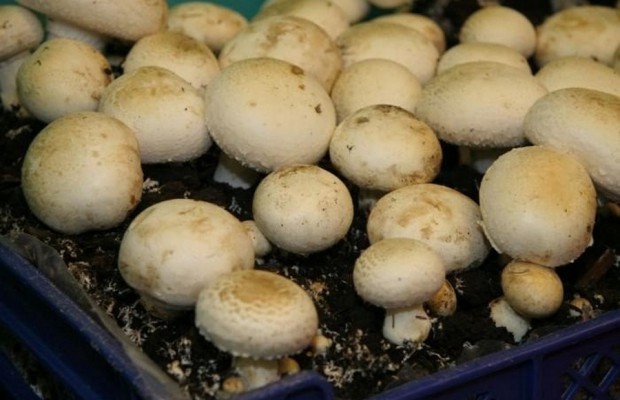
Important! The compost left over from the mushroom harvest cannot be reused as fertilizer or mixed with new compost. It is toxic and hazardous to health; mushrooms in such compost will grow poisonous.
Features of growing oyster mushrooms
Delicious and light oyster mushrooms grow on open and damp poles of trees infected with myceliums. The same principle is used in greenhouse cultivation, but it's a little more complicated.
Video: features and mistakes of growing oyster mushrooms
Soil preparation
Wooden blocks can be used as a substrate.but their preparation takes a long time. It is necessary to carry out a huge amount of work (make a few punctures and cracks, soak in an aqueous solution in order to achieve optimal wood moisture and temperature conditions). Infection of such a bar with mycelium occurs for a long time (3-4 months), but such soil bears fruit for a very long time and can be reused.
The most common way to grow oyster mushrooms in a greenhouse is to hang special bags infected with mycelium... To prepare such a bag you will need:
- woody tyrsa (10 kg);
- peat (1 kg);
- superphosphate (30 g);
- urea (30 g);
- water (3 l).
All ingredients must be thoroughly mixed and placed in a special bag that will serve. The compost takes 4-5 days to prepare. Its temperature should not be lower than 13 ° C.
Attention! After the last harvest of oyster mushrooms has been harvested, this substrate can be used as fertilizer for fruit trees. It is enough just to scatter it at the roots. Recycling compost is ineffective as the wood becomes rotten.
Landing
The mycelium must be evenly mixed together with the fertile soil, then put back in the bag and make several small holes in a checkerboard pattern at a distance of 15 cm from each other. The hole provides oxygen access and it is in these holes that myceliums will form.
Care
At this stage, the air temperature should be at least 25 ° C, and the humidity 85% -90%. This stimulates the growth of fruiting bodies. After sprouting, which will appear within a week after sowing, the temperature is reduced to 10 ° C. Now it is important to avoid oversaturation of moisture, as young formed myceliums can freeze. Watering is carried out every 4 days.
Harvesting
Already 10-12 days after sowing, you can harvest, and then every 4 days. The fruiting period lasts 1.5-2 months on average.
If wooden bars were used as a fertile base, the fruiting period will be much longer, namely 3-4 months, which allows you to double the amount of oyster mushrooms harvested.
Video: stages of growing oyster mushrooms - from hay to the first mushrooms
Features of growing porcini mushrooms
The most difficult to grow in greenhouse conditions are porcini or boletus. Grow them at home impossible... Why? Read in this article.
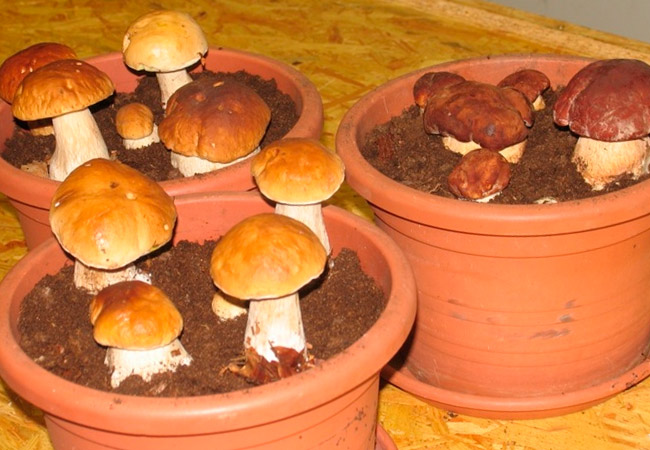
Note! The following is a theoretical instruction for growing porcini mushrooms in parallel universesince they are absolutely not suitable for unnatural cultivation.
Substrate preparation
Porcini mushrooms are forest plants, and, accordingly, the soil for their cultivation should imitate forest ones. It is best if the substrate is taken from a coniferous forest. It is enough just to dig out the top layer of dry leaves and collect woody soil. It is ideal for growing porcini mushrooms.
But you can also prepare the substrate yourself. This will require small branches of conifers, dry leaves, tree bark. All this must be crushed to a powder state in special garden grinders for branches and leaves. The resulting mass is mixed with clean sandy soil in proportions 1: 1. The soil is ready.
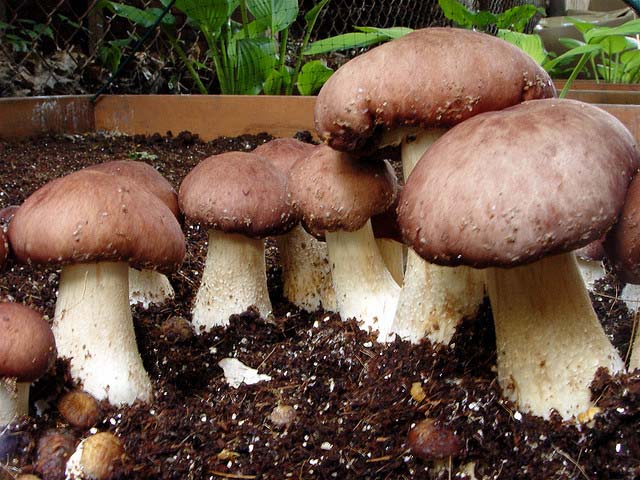
Landing
Directly planting a porcini mushroom for growing in a greenhouse is carried out according to certain rules. As a planting material, you can use dried and wormy fruits collected in the forest.
Technology of planting porcini mushrooms in the greenhouse:
- It is necessary to separate the legs from the caps and soak the latter in a weak solution of potassium permanganate for 2-3 hours.
- If the mushroom caps are too dry to stimulate the release of spores, alcohol can be added to the water (one teaspoon per liter of water).
- Next, you need to insist the caps in the water before planting.
- Cut each cap into 4 pieces.
- Boil water and dissolve granulated sugar in it at the rate of 1 tablespoon per 1 liter of water.
- When the water has cooled to room temperature, soak the caps in it for 2 hours.
- Each piece will serve as a mycelium with which mushrooms will sprout in the future.
For planting, it is best to use plastic containers of 4-5 liters, in each of which 1-2 parts of the cap are planted. Disembarkation takes place from May to October.
Care
After planting, an optimum temperature of 23 ° C-25 ° C must be ensured. As soon as the first shoots appear, the temperature is reduced to 17 ° C. The air humidity should be 80-85% throughout the entire period of growth of porcini mushrooms in the greenhouse.
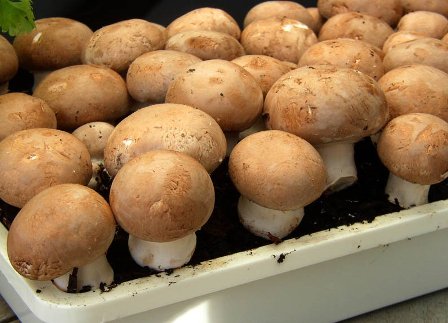
Harvesting
Boletus is a very capricious mushroom, and mycelium can begin to bear fruit only six months or a year after planting. After germination, in a week you can harvest large, full-fledged fruits. The mycelium is capable of bearing fruit up to 7-8 times. From one mycelium, you can collect from 2 to 4 kg of porcini mushrooms.
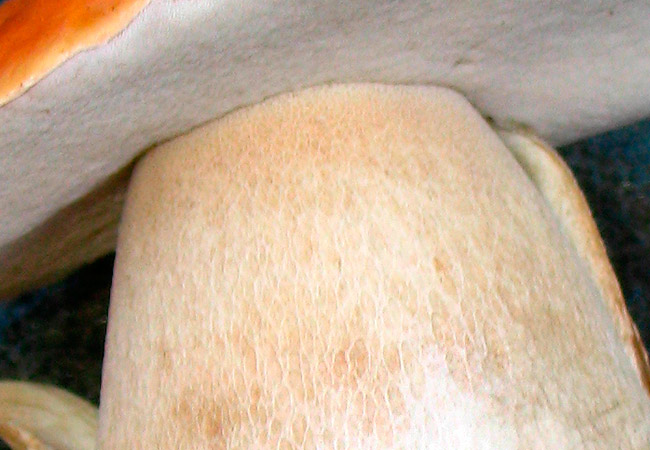
Based on all of the above, growing mushrooms in greenhouses is an absolutely simple task and does not require any special knowledge and skills. A competent and responsible approach to business is a guarantee of a good harvest. Perhaps the only unpleasant moment may be the financial part, since the equipment will have to be bought, because it will not work to make it on your own.
The cultivation process requires compliance with certain rules, namely: maintaining the temperature regime, illumination and systematic moisture. The process of growing mushrooms in a greenhouse does not provide for any additional actions. Thanks to the rational use of the summer cottage and the garden, you can not only pamper yourself with fresh mushrooms all year round, but also turn this business into a profitable business!

